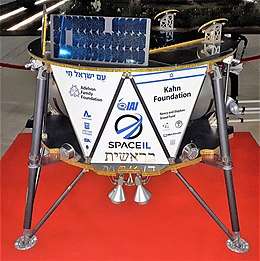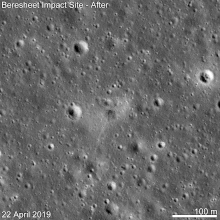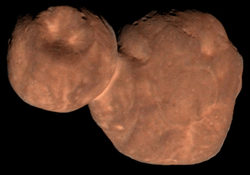Beresheet
Beresheet (Hebrew: בְּרֵאשִׁית, "Bərēšīṯ", "In the beginning"; Book of Genesis) was a demonstrator of a small robotic lunar lander and lunar probe operated by Israel Aerospace Industries. Its aims included promoting careers in science, technology, engineering, and mathematics (STEM), and landing its magnetometer, digital time capsule, and laser retroreflector on the Moon. The lander's gyroscopes failed on 11 April 2019 causing the main engine to shut off, which caused the lander to crash on the Moon.[9] Its final resting position is 32.5956°N, 19.3496°E.[10]
 Full size model of the Beresheet Moon lander | |||||||
| Names | Sparrow (2011-2018) | ||||||
|---|---|---|---|---|---|---|---|
| Mission type | Technology demonstrator | ||||||
| Operator | |||||||
| COSPAR ID | 2019-09B | ||||||
| SATCAT no. | 44049 | ||||||
| Website | www | ||||||
| Mission duration | Final: 48 days, 17 hours, 38 minutes | ||||||
| Spacecraft properties | |||||||
| Spacecraft | Beresheet[2] | ||||||
| Spacecraft type | Lunar lander | ||||||
| Manufacturer | Israel Aerospace Industries[3] | ||||||
| Launch mass | 585 kg (1,290 lb) | ||||||
| Dry mass | 150 kg (330 lb) | ||||||
| Dimensions | diameter: 2 m (6.6 ft); height: 1.5 m[4] | ||||||
| Start of mission | |||||||
| Launch date | 22 February 2019 1:45 UTC[5] [6] | ||||||
| Rocket | Falcon 9 B5 | ||||||
| Launch site | CCAFS SLC-40 | ||||||
| Contractor | SpaceX | ||||||
| End of mission | |||||||
| Disposal | Destroyed upon impact on the Moon surface | ||||||
| Destroyed | 11 April 2019, 19:23 UTC | ||||||
| Moon lander | |||||||
| Landing date | Lunar capture: 4 April 2019 Landing: 11 April 2019 (failure)[7] | ||||||
| Landing site | Mare Serenitatis[8] | ||||||
| |||||||
The lander was previously known as Sparrow and was officially renamed to Beresheet in December 2018.[11] Its net mass was 150 kg (330 lb); when fueled at launch, its mass was 585 kg (1,290 lb). It had been compared to a washing machine, as it stood at about the height of one at 1.5 m (4 ft 11 in) and was similar in width to large household appliances.[12] It used seven ground stations for Earth–lander communication.[13] Its mission control center was at Israel Aerospace Industries in Yehud, Israel.
The Beresheet was the first non-governmental mission to land (albeit destructively) on the Moon, first Israeli mission to land on the Moon, the first ride-share mission to land on the Moon and the smallest spacecraft to aim and reach the Moon.[14]
Planning and construction
Beresheet was co-developed by SpaceIL – a non-profit organization headed by Morris Kahn, its major financier – and Israel Aerospace Industries (IAI). It represented the first privately initiated Moon mission and was stimulated by the Google Lunar X Prize.[15] IAI constructed the vehicle[16][3] and was supported by the Israel Space Agency.[17] The time window for participation in the Lunar X Prize closed before the launch. After the mission, Lunar X Prize awarded a US$1 million award to SpaceIL to support a second mission.[18]
The costs for the project, including launch, were about US$100 million.[19] The government of Israel's commitment to the project was stated to be 10% in July 2018.[20] However, in 2019 just before the launch, SpaceIL told media that the overall budget was about $90 million, and only about $2 million of that came from the Israeli government.[21]
Payload
The spacecraft carried a digital "time capsule" containing over 30 million pages of data, including a full copy of the English-language Wikipedia, the Wearable Rosetta disc, the PanLex database, the Torah, children's drawings, a children's book inspired by the space launch, memoirs of a Holocaust survivor, Israel's national anthem ("Hatikvah"), the Israeli flag, and a copy of the Israeli Declaration of Independence.[22][23][24][5][25] At the last minute, genetic samples and tardigrades were added in epoxy resin between the digital layers.[26]
Its scientific payload included a magnetometer supplied by the Israeli Weizmann Institute of Science to measure the local magnetic field, and a laser retroreflector array supplied by NASA's Goddard Space Flight Center to enable precise measurements of the Earth–Moon distance.[27][28]
Propulsion
The spacecraft propulsion system was designed and built by Israel Aerospace Industries, based on monomethylhydrazine (MMH) fuel and mixed oxides of nitrogen (MON) oxidizer. It featured nine engines, the main engine was the LEROS 2b liquid-propellant, restartable rocket engine which was used to reach lunar orbit, as well as for deceleration of the spacecraft, destructive lithobraking, and an attempted propulsive landing.[29][30]
Launch

In October 2015, SpaceIL signed a contract for a launch from Cape Canaveral in Florida on a SpaceX Falcon 9 booster, via Spaceflight Industries.[20][31] It was launched on 22 February 2019 at 0145 UTC (20:45 local time on 21 February) as a secondary payload,[5][32][33] along with the telecom satellite PSN-6.[34] Beresheet was controlled by a command center in Yehud, Israel.[35]
From 24 February to 19 March, the main engine was used four times to raise the orbit, putting its apogee close to the Moon's orbital distance.[36] The spacecraft performed maneuvers so as to be successfully captured into an elliptical lunar orbit on 4 April 2019, and adjusted its flight pattern in a circular orbit around the Moon. Once it was in the correct circular orbit, it was planned to decelerate for a soft landing on the lunar surface. This was planned for 11 April 2019.[37]
Planned landing site
The planned landing site was in the north part of the Mare Serenitatis,[8] and the landing zone was about 15 km (9.3 mi) in diameter.[38]
Beresheet was planned to operate for an estimated two days on the lunar surface,[20] as it had no thermal control and was expected to quickly overheat.[39] However, its laser retroreflector was a passive device requiring no electrical power and was expected to be functional for several decades.[40]
Planned operations
The spacecraft was planned to have a short lifespan of about two days. Its main mission would have been to gather imagery and send it back to Earth. Additionally, the craft would have made magnetic measurements. It was also planned to reignite its main engine and perform a "hop" to another place in the Moon's surface, demonstrating relocation capability in its Moon exploration.[21]
The retroreflector onboard Beresheet was a passive device and would have continued to be usable to laser ranging measurements for decades after the spacecraft's active life ended.
NASA contribution
In addition to contributing the laser retroreflector to the mission, NASA planned to contribute space communications capabilities during the cruise phase and operations phase, even giving Beresheet time on the Deep Space Network. NASA also planned to survey Beresheet with its Lunar Reconnaissance Orbiter (which it did after the crash-landing). In exchange, SpaceIL would have shared its magnetic measurements with NASA.[21]
Crash-landing

On 11 April 2019, the lander crash-landed on the lunar surface. An Inertial Measurement Unit (IMU2) gyroscope failed during the braking procedure on approach to the landing site, and the ground control crew was unable to reset the individual component due to a sudden loss of communications with the control network.[41] By the time communications were restored, the craft's main engine had already been inactive for an extended period. The engine was brought back online following a system-wide reset; however, the craft had already lost too much altitude to slow its descent sufficiently. The final telemetry reading indicated that at an altitude of 150 metres (490 ft) the craft was still traveling over 500 km/hour (139 m/s), resulting in a total loss on impact with the lunar surface.[42][43] Prior to impact, the probe had been able to take two last photographs: a view of itself against the Moon, and a closer shot of the Moon's surface.[44]
The lander's final resting position is 32.5956°N, 19.3496°E,[10] portrayed in the following LROC images:[45]
Wreckage
NASA's Lunar Reconnaissance Orbiter (LRO) overflew the area where Beresheet's telemetry ended, and took photos of the surface. When those photos were compared against earlier photos of the same location, one set of new features was obvious. A faint lighter line leads to a lighter halo surrounding a dark crater. A lump is visible at the head of the crater opposite the line. The light halo may either be gas associated with the craft's wreckage or fine soil particles blown outward by the impact.[48] A small NASA payload known as the Lunar Retroflector Array (LRA) is hoped to have survived the crash but may have separated from the remaining wreckage. The Lunar Orbiter Laser Altimeter (LOLA) instrument on the LRO is pulsing laser images at the crash site in hopes of finding the LRA.[49]
In August 2019, scientists reported that a capsule containing tardigrade micro-animals in their natural cryptobiotic state may have survived the crash and lived on the Moon for a while. On previous space missions, tardigrades were exposed to the open vacuum of space and some were able to live for a period of time.[50][51] But there is no real danger they will spread across the Moon.[50]
Beresheet 2
Originally Beresheet was planned to be a one-time-only mission.[21][3] However, on 13 April 2019, Morris Kahn announced that a new mission, named Beresheet 2 would attempt a second time to land on the Moon.[52] But on 26 June 2019, SpaceIL announced that the mission will not target the Moon, and instead it will be to another, undisclosed object.[53][54]
Intellectual property
IAI owns the intellectual property of the Beresheet design.[55] On 9 June 2019 it was announced that IAI signed an agreement with the American company Firefly Aerospace to build a lunar lander based on Beresheet.[55] Firefly Aerospace is one of several 'main contractors' for NASA's Commercial Lunar Payload Services (CLPS), and they plan to propose a lunar lander based on Beresheet that will be called Genesis.[55][56] Genesis would be launched on another vehicle Firefly plans to build, called Beta.[56]
See also
- List of artificial objects on the Moon
References
- This 'Sparrow' lunar lander may soon make Israel the 4th country to land the Moon. Dave Mosher, Business Insider. 14 August 2018.
- SpaceX Delays Launch of First Private Lunar Lander Without Explanation. Kristin Houser, Futurism. 18 December 2018.
- IAI studying follow-on opportunities for SpaceIL lunar lander. Jeff Foust, Space News. 17 September 2018.
- "Israeli unmanned spacecraft to land on Moon in 2019". BBC News. 10 July 2018.
- Graham, William (21 February 2019). "SpaceX launches Indonesian satellite launch and Israeli moon mission". NasaSpaceFlight.com. Retrieved 23 February 2019.
- Pietrobon, Steven (8 December 2018). "United States Commercial ELV Launch Manifest". Retrieved 8 December 2018.
- Israeli spirits soar as Moon launch countdown begins, 18 February 2019
- Here's (almost) everything you need to know about Israel's Moon lander. Jason Davis, The Planetary Society. 8 November 2018.
- Lidman, Melanie. "Israel's Beresheet spacecraft crashes into the moon during landing attempt". Times of Israel.
- "Beresheet Crash Site Spotted! | Lunar Reconnaissance Orbiter Camera". lroc.sese.asu.edu. Retrieved 19 September 2019.
- SpaceIL, IAI to send time capsule on Israel's historic Moon mission. SpaceIL website. Accessed on 17 December 2018.
- "Tiny Israeli spacecraft Beresheet enters orbit around the moon". Retrieved 23 May 2019.
- SpaceIL - Technology Archived 10 April 2019 at the Wayback Machine. Accessed on 6 March 2019.
- https://www.iai.co.il/p/moon-lander
- Deutsche Welle (www.dw.com) (19 February 2019). "Israel schickt ersten privat finanzierten Mond-Lander auf den Weg". Retrieved 11 April 2019.
- https://astronaut.com/spaceil-says-chain-of-events-led-to-crash-of-lunar-lander/
- Christine Lunsford (9 February 2019). "Israel's 1st Moon Lander: The SpaceIL Beresheet Lunar Mission in Pictures". Retrieved 19 February 2019.
- Mike Wehner (12 April 2019). "We now know why Israel's lunar lander crashed into the Moon". BGR. Retrieved 14 April 2019.
- Mike Wall (4 April 2019). "Pioneering Israeli Lunar Lander Arrives in Orbit Around the Moon". Space.com. Retrieved 11 April 2019.
- Winner, Stewart; Solomon, Shoshanna (10 July 2018). "Israeli spacecraft aims for historic moon landing… within months". The Times of Israel. Retrieved 11 July 2018.
- https://www.theverge.com/2019/2/19/18228611/spaceil-israel-lunar-lander-beresheet-spacex-falcon-9-mission
- Chang, Kenneth (21 February 2019). "After SpaceX Launch, Israeli Spacecraft Begins Journey to the Moon". The New York Times. ISSN 0362-4331. Retrieved 23 February 2019.
- Holmes, Oliver (20 February 2019). "Israel to launch first privately funded moon mission". The Guardian. ISSN 0261-3077. Retrieved 22 February 2019.
- Shafi Musaddique (21 February 2019). "Israel to take 'digital bible' to space as it becomes fourth country to land on the Moon". euronews.com. Retrieved 22 February 2019.
- "The first library on another celestial body". www.archmission.org. Retrieved 11 April 2019.
- Oberhaus, Daniel (5 August 2019). "A Crashed Israeli Lunar Lander Spilled Tardigrades on the Moon". Wired. Retrieved 6 August 2019.
- Potter, Sean (3 October 2018). "NASA, Israel Space Agency Sign Agreement for Commercial Lunar Cooperat". NASA. Retrieved 3 December 2018.
- NASA Video (29 November 2018), NASA Announces New Moon Partnerships with U.S. Companies, retrieved 3 December 2018
- Amos, Jonathan (21 February 2019). "Israel's Beresheet robot sets its sights on the Moon". BBC News Online.
- Lunde, Endre. "Nammo's British Rocket Engine Powers Israel's Mission to the Moon". Mynewsdesk. Endre Lunde, Senior Vice President, Communications, +4790853270
- Israeli GLXP Team Is First to Sign Launch Agreement For Private Mission to the Moon On SpaceX Falcon 9, 7 October 2015
- SpaceX Falcon 9 rideshare launch to send a commercial lander to the Moon in 2019. Eric Ralph, Teslarati. 12 September 2018.
- Ronel, Asaf (10 July 2018). "First Israeli Spacecraft to Head to Moon on Back of Elon Musk's SpaceX Rocket". Haaretz. Retrieved 10 July 2018.
- SpaceIL making final fundraising push for lunar lander mission. Jeff Foust, SpaceNews. 14 December 2017.
- staff. "Israeli lunar craft successfully completes first maneuver". Times of Israel. Retrieved 2 April 2019.
- "Beresheet lander on course for the moon". 19 March 2019. Retrieved 3 April 2019.
- "Recalculating Route: The plan of spacecraft's trajectory has been completed". SpaceIL. July 2018.
- Landing site selection for the SpaceIL mission to the Moon. Yuval Grossman. Lunar And Planetary Science. Conference XLVIII. March 2017.
- With SpaceIL launch, its to the moon and beyond for Israel. Yaakov Lappin, Heritage. 11 January 2019.
- David, Leonard (31 March 2019). "NASA's Piggyback Experiment on Israeli Moon Lander Could Aid Future Lunar Touchdowns". Space.com. Retrieved 14 April 2019.
- LIVE broadcast - Beresheet lands on the Moon Fasten your seatbelts, we are about to land (Live videocast). Yehud, Israel: SpaceIL. 11 April 2019. Retrieved 12 April 2019. commentary beginning 32'56" (combined Hebrew and English)
- Foust, Jeff (12 April 2019). "SpaceIL says "chain of events" led to crash of lunar lander". SpaceNews. Retrieved 12 April 2019.
- Chang, Kenneth (11 April 2019). "Israel's Beresheet Spacecraft Moon Landing Attempt Appears to End in Crash". The New York Times. Retrieved 11 April 2019.
- Dent, Steve (14 April 2019). "Israel's Moon probe snaps a final photo before crashing". Engadget. Retrieved 14 April 2019.
- "Available NAC images for Beresheet crash site".
- "LROC Observation M1098722768L".
- "LROC Observation M1101080642R".
- Howell, Elizabeth (15 May 2019). "Moon Crash Site Found! NASA Probe Spots Grave of Israeli Lunar Lander". SpaceNews. Retrieved 23 May 2019.
- David, Leonard (17 April 2019). "Did NASA Experiment Survive Israeli Moon Lander's Crash?". SpaceNews. Retrieved 23 May 2019.
- Oberhaus, Daniel (5 August 2019). "A Crashed Israeli Lunar Lander Spilled Tardigrades on the Moon". Wired. Retrieved 6 August 2019.
- Resnick, Brian (6 August 2019). "Tardigrades, the toughest animals on Earth, have crash-landed on the moon - The tardigrade conquest of the solar system has begun". Vox. Retrieved 6 August 2019.
- "SpaceIL". Facebook.
- SpaceIL: Beresheet won't attempt moon landing, will seek another challenge. Eytan Halon and Hagay Hacohen, The Jerusalem Post. 26 June 2019.
- Israeli team will no longer send a second spacecraft to the Moon. Natt Garun, The Verge. 26 June 2019.
- Firefly to partner with IAI on lunar lander. Jeff Foust, Space News. 9 July 2019.
- Israel’s failed lunar lander will live on in the design of Firefly Aerospace's new Moon spacecraft. Loren Grush, The Verge. 9 July 2019.
External links

- Official website

- From Plutarch to Beresheet: a Short History of Lunar Exploration



